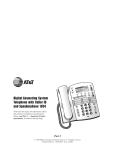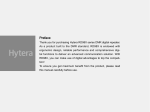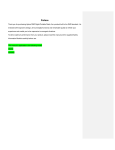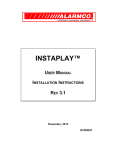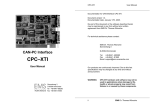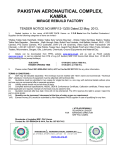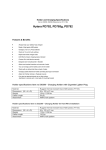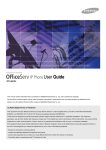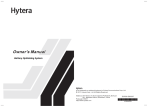Download Preface - HAM
Transcript
Preface Thank you for purchasing Hytera DMR digital mobile radio. As a product built to the DMR standard, the mobile radio is endowed with ergonomic design and comprehensive digital functions to deliver an advanced communication solution. With it, you can make use of digital functions to top the competition! To derive optimum performance from your radio, please read this manual and the supplied Safety Information Booklet carefully before use. Icon Information The following icons are available through this manual: Alert Icons Caution: indicates situations that could cause damage to your radio. Note: indicates tips that can help you make better use of your radio. Function Icons : indicates functions that are available on digital channel only. : indicates functions that are available on analog channel only. Functions marked with no function icons are available on both analog and digital channels. Term Explanation Key Operation Short press: to press a key and release it quickly; Long press: to press a key and remain holding it down for a predefined period (2 seconds by default); Hold down: to press a key and remain holding it down. Private Call Private call is initiated by a single user to another user, involving the calling party and the called party only. Group Call Group call is initiated by a single user to a group, involving the calling party and all the group members. All Call All call is a call initiated to all the users on a channel. It is used to deliver important notices. Squelch This technology can remove excessive background noises, improving your communication quality. Copyright Information Hytera and HYT are trademarks or registered trademarks of Hytera Communications Co., Ltd. in the PRC and/or other countries or areas. Hytera retains the ownership of its trademarks and product names. All other trademarks and/or product names that may be used in this manual are properties of their respective owners. The Hytera product described in this manual may include Hytera computer programs stored in memory or other media. Laws in the PRC and/or other countries or areas preserve for Hytera exclusive rights for Hytera computer programs. The purchase of this product shall not be deemed to grant, either directly or by implication, any rights to the purchaser with respect to Hytera computer programs. Any Hytera computer programs may not be copied, modified, distributed, decompiled, or reverse-engineered in any manner without the prior written consent of Hytera. The AMBE+2TM voice coding technology embodied in this product is protected by intellectual property rights including patent rights, copyrights and trade secrets of Digital Voice Systems, Inc. This voice coding technology is licensed solely for use within this product. The user of this technology is explicitly prohibited from attempting to decompile, reverse engineer, or disassemble the Object Code or in any other way convert the Object Code into a human readable form. U.S. Patent Nos. #6,912,495 B2, #6,199,037 B1, #5,870,405, #5,826,222, #5,754,974, #5,701,390, #5,715,365, #5,649,050, #5,630,011, #5,581,656, #5,517,511, #5,491,772, #5,247,579, #5,226,084 and #5,195,166. Disclaimer Hytera endeavors to achieve the accuracy and completeness of this manual, but no warranty of accuracy or reliability is given. All the specifications and designs are subject to change without notice due to continuous technology development. No part of this manual may be copied, modified, translated, or distributed in any manner without the express written permission of Hytera. If you have any suggestions or would like to learn more details, please visit our website at http://www.hytera.cn. RF Energy Exposure Compliance Your radio is designed and tested to comply with a number of national and international standards and guidelines (listed below) regarding human exposure to radio frequency electromagnetic energy. This radio complies with the IEEE and ICNIRP exposure limits for occupational/controlled RF exposure environment at operating duty factors of up to 50% transmitting and is authorized by the FCC for occupational use only. In terms of measuring RF energy for compliance with the FCC exposure guidelines, your radio radiates measurable RF energy only while it is transmitting (during talking), not when it is receiving (listening) or in standby mode. Your radio complies with the following of RF energy exposure standards and guidelines United States Federal Communications Commission, Code of Federal Regulations; 47CFR part 2 sub-part J American National Standards Institute (ANSI)/Institute of Electrical and Electronic Engineers (IEEE) C95. 1-1992 Institute of Electrical and Electronic Engineers (IEEE) C95. 1-1999 Edition International Commission on Non-Ionizing Radiation Protection (ICNIRP) 1998 Operational Instructions and Training Guidelines To ensure optimal performance and compliance with the occupational/controlled environment RF energy exposure limits in the above standards and guidelines, users should transmit no more than 50% of the time and always adhere to the following procedures: Transmit and Receive To transmit (talk), push the Push-To-Talk (PTT) key; to receive, release the PTT key. FCC Licensing Information Part 15 Compliance This equipment has been tested and found to comply with the limits for a Class B digital device, pursuant to part 15 of the FCC Rules. These limits are designed to provide reasonable protection against harmful interference in a residential installation. This equipment generates, uses and can radiate radio frequency energy and, if not installed and used in accordance with the instructions, may cause harmful interference to radio communications. However, there is no guarantee that interference will not occur in a particular installation. If this equipment does cause harmful interference to radio or television reception, which can be determined by turning the equipment off and on, the user is encouraged to try to correct the interference by one or more of the following measures: Reorient or relocate the receiving antenna. Increase the separation between the equipment and receiver. Connect the equipment into an outlet on a circuit different from that to which the receiver is connected. Consult the dealer or an experienced radio/TV technician for help. FCC Licensing Requirements A license from Federal Communications Commission is required prior to use. Your dealer will program each radio with your authorized frequencies, signaling codes, etc., and will be there to meet your communications needs as your system expands. Contact your dealer for more information. Contents Checking Items in the Package------------------------ 1 Zone----------------------------------------------------------- 13 Radio Overview-------------------------------------------- 2 Settings------------------------------------------------------- 13 Front Panel-------------------------------------------------- 2 Functions and Operations------------------------------- 16 Rear Panel--------------------------------------------------- 2 Standby Screen--------------------------------------------- 16 Programmable Keys--------------------------------------- 2 Scan----------------------------------------------------------- 16 Installation--------------------------------------------------- 4 Public Address---------------------------------------------- 16 Status Indicators------------------------------------------- 6 Talk Around-------------------------------------------------- 17 LCD Icons---------------------------------------------------- 6 Monitor --------------------------------------------------- 17 LED Indicator------------------------------------------------ 7 Squelch Off Basic Operations------------------------------------------- 8 Emergency--------------------------------------------------- 18 Turning the Radio On/Off--------------------------------- 8 Ignition Sense----------------------------------------------- 20 Adjusting the Volume-------------------------------------- 8 Busy Channel Lockout------------------------------------ 21 Selecting a Zone------------------------------------------- 8 Time-out Timer (TOT)------------------------------------- 21 Selecting a Channel--------------------------------------- 8 Troubleshooting-------------------------------------------- 22 Digital/Analog Switch-------------------------------------- 8 Care and Cleaning---------------------------------------- 24 Call------------------------------------------------------------- 9 Optional Accessories------------------------------------- 25 Menu Navigation------------------------------------------- 11 Contact Message ------------------------------------------------- 11 Call Logs ------------------------------------------------- 12 Scan----------------------------------------------------------- 12 --------------------------------------------------- 11 - -------------------------------------------- 17 Appendix Input Method----------------------------------- 26 Checking Items in the Package Please unpack carefully and check that all items listed below are received. If any item is missing or damaged, please contact your dealer. Radio Unit Palm Microphone Mounting Bracket Kit Microphone Hanger and Screws Power Cord Fuse Owner’s Manual /Quick Reference Guide/Safety Information Booklet Owner’s Manual Safety Information Booklet Quick Referen ce Gui de Radio Overview Rear Panel Front Panel No. Part Name No. Part Name No. Part Name No. Part Name 1 BNC Antenna Connector 2 Power Inlet 3 Accessory Jack 4 GPS Antenna Connector Volume Control / Channel Selector Knob 2 3 LCD Display 4 OK/Menu Key 5 Back Key 6 Power On/Off key 7 Up Key 8 Down Key Programmable Keys 9 Speaker 10 Programmable Keys 11 Microphone Jack 12 Emergency Key For enhanced convenience, you may request your dealer 1 LED Indicator to program the keys P1, P2, P3, P4, Emergency key, and as shortcuts to the functions listed below: Radio Overview No. Shortcut Keys Description 1 Zone Up Quick access to desired zone 2 Zone Down Quick access to desired zone 3 Message Quick access to the menu “Message” 4 Contact List Quick access to Contact List 5 Call Log Quick access to the menu “Call Logs” 6 Adjusting Power Level To adjust power level through one button press. 7 Public Address To allow public addressing via the external speaker. 8 Talk Around To directly communicate with other radios. 9 Monitor To adjust the condition for incoming signal match. 10 Monitor Momentary To adjust the condition for incoming signal match. 11 Squelch Off To always unmute speaker no matter whether carrier is present or not. 12 Squelch Off Momentary To always unmute speaker no matter whether carrier is present or not. 13 Home Screen To quickly return to the previous menu or the home screen. 14 Scan To receive signals on other channels. 15 Nuisance Temporary Delete To temporarily ignore unwanted channel activity. 16 Emergency To summon help in emergent situations. 17 Adjusting Squelch Level To temporarily adjust the squelch threshold required for the radio to unmute. Note: Long and short press of a key can be assigned with different functions by your dealer. Installation Before you install the radio in a vehicle, be sure to read the following instructions carefully: Instructions The radio operates with negative grounded power supply of 13.2±15%V only. Please check polarity and voltage of the power supply on vehicle before you install the radio. Please check how long the screws will extend from the bottom surface of radio, before you install the radio. Be sure to drill mounting hole with caution, to avoid damage of the vehicle wiring and parts. Please connect the supplied antenna and power cord to the radio, before you install the radio in the bracket. Install the radio with Hytera supplied mounting bracket, to avoid radio loose in case of accidents. The loose radio may cause bodily injury. Install the radio in a location where it’s easy to reach the front panel controls. Please make sure there’s sufficient space at back of the radio for wiring. When the fuse for DC power cord needs replacement, it must be replaced by a fuse with the same specification. Installation Tools Electric drill Cross head screwdriver Hex socket sleeve (used for 4.8*20mm self-tapping screws) Installation Installation Steps A Install the bracket in a location where it’s easy to operate the radio. B C D E No. Part Name Connect accessories such as antenna and power cord to the radio. 1 Radio Unit 2 BNC Antenna Connec tor Slide the radio into the mounting bracket and secure it using the locking knobs. 3 Locking Knobs 4 Mounting Bracket 5 4.8 * 20 mm Self- tapping Screws Install the microphone hanger in a location where it’s easy to reach the microphone. Plug the palm microphone into the microphone jack on the front panel, and place it on the hanger when you do not use it. 6 Power Inlet 7 Black Power Cord 8 Red Power Cord 9 Fuse 10 Palm Microphone 11 Microphone Hanger 12 4 * 16 mm Self-tapping Screws Status Indicators LCD Icons Scanning is in progress The LCD of your radio displays the radio status, text entries, and menu items. The following are the icons that appear on the radio’s display. Scanning pauses on a nonpriority channel Scan Icons Standby Interface Scanning pauses on Priority Channel 2 Tx Power Icons Status Icons Icon Name Icon Radio Status No signal RSSI Message Icons Scanning pauses on Priority Channel 1 Monitor Icon Speaker Icon Emergency Icon More bars indicate better signal strength New Message/Unread Message Inbox is full Knob Operation Mode Icons Low Tx power for the current channel High Tx power for the current channel Monitor function is active Speaker is unmuted Emergency mode (other than secret emergency) is active or an emergency message is received The knob currently operates in channel selection mode The knob currently operates in volume adjustment mode Status Indicators Operation Mode Icons Icon Name Operation Mode Icon Operation Mode Direct Mode: Under this mode, radios communicate with each other directly. Repeater Mode: Under this mode, radios communicate with each other via a repeater. LED Indicator The LED indicator will help you easily identify current radio status. LED Indicator Radio Status LED flashes green Powering on LED glows red Transmitting LED glows green Receiving LED flashes orange Scanning is in progress Basic Operations Turning the Radio On/Off To turn the radio on, hold down the Power On/Off key until the following indications are given: the radio shows the power-up screen and sounds power-up alert, and LED flashes green. To turn the radio off, long press the Power On/Off key. Adjusting the Volume When the Volume Control / Channel Selector knob operates in volume adjustment mode (the radio displays the icon ), rotate the knob clockwise to increase the volume, or counter-clockwise to decrease the volume. Alert tone volume is programmable by your dealer. Selecting a Zone A zone is a group of channels exhibiting the same property, and is programmed by your dealer. The radio supports up to 32 zones, each with a maximum of 16 channels. You may select a zone through any of the following methods: 1. Through menu selection Go to the Zone menu, and use the Up/Down keys to select your desired zone. 2. Through the function keys You may quickly toggle to your desired zone, through press of the programmed Zone Up or Zone Down key. Note: You dealer may designate the power-up zone and channel. If not, the radio will enter the zone and channel last used. Selecting a Channel Press the Volume Control / Channel Selector knob to switch it to channel selection mode (the radio displays the icon ), and then rotate the knob to select your desired channel. Alias of the current channel will appear on the standby screen. Note: The knob is in volume adjustment mode by default, and will return to this mode in 5 seconds after you select a channel. Digital/Analog Switch Each channel can be programmed as either analog channel or digital channel. If the current zone includes both analog and digital channels, you may quickly switch between digital and analog channels through the Volume Control / Channel Selector knob. When switching from digital to analog mode, some features such as Message will be unavailable. Basic Operations Call Transmitting a Private Call You may transmit a Private Call through any of the following methods. When transmitting a Private Call, the icon will appear. Transmitting a call to the preset contact In standby mode, pressing PTT key will transmit an individual call to the contact (a Private Call number) preset for the current channel. Note: Your dealer may preset a contact for each digital channel. The preset contact could be a Private Call number, a Group Call number or an All Call number. Transmitting a call through Contact List or Call Logs 1 Go to Contact -> Contact List, or go to Call Logs -> Call List. 2 Use the Up/Down key to select the Private Call number you want to call. 3 Hold down PTT key to transmit a Private Call to the selected contact. Transmitting a call through Manual Dial 1 Go to Contact -> Manual Dial. 2 Input a Private Call number you want to call. 3 Hold down PTT key to transmit a call. Transmitting a Group Call You may transmit a Group Call through any of the following methods. When transmitting a Group Call, the icon will appear. Transmitting a call to the preset contact In standby mode, pressing PTT will transmit a Group Call to the contact (a Group Call number) preset for the current channel. Transmitting a call through Contact List 1 Go to Contact -> Contact List. 2 Use the Up/Down key to select the Group Call number you want to call. 3 Hold down PTT to transmit a Group Call to the selected contact. Transmitting an All Call Methods are the same as those in Transmitting a Group Call. When transmitting an All Call, the icon appear. will Basic Operations Note: You can transmit an All Call only when it is enabled by your dealer. Receiving and Responding to a Call Receiving a Call When a call is received, your radio will display the corresponding icon as follows: for a Group Call and for a Private Call, for an All Call. Responding to a Private/Group Call After a Private Call or Group Call is received, you may press the PTT key within the preset time period to call back. If you do not respond to a received Private Call, the radio will display the missed call icon . Note: You cannot respond to an All Call. Calls on Analog Channels To transmit on an analog channel, hold down the PTT and speak into the microphone. To receive, release the PTT. 10 Menu Navigation Editing a Contact You can edit the number and alias of each private contact. Viewing a Contact You can view details of each contact. Deleting a Contact You can delete a Private Call contact. However, please note that you can not delete the contact when there is only one entry left in the list. In addition, the individual contact preset on the digital channel cannot be deleted either. Contact To access this item, press Menu key in idle mode and then select “Contact”. New Contact You can add a Private Call contact to the contact list. The available contact number is 1 to 16776415. Manual Dial You can manually input the Private Call number for calling. Message Contact List You can save up to 200 entries in the list. To access this item, select “Contact -> Contact List” or press the shortcut key for Contact List. 11 To access this item, press Menu key in idle mode and then select “Message”, or press the shortcut key for Message directly. Menu Navigation New Message You can create your desired text message (256 characters at most) and send it to an individual user or to a talk group. Quick Text Under this option there are some text messages (10 entries at most) preset by your dealer. You can choose to edit and send any entry. To delete all messages in the outbox, select “Message -> Outbox -> Delete All”. Call Logs To access this item, press Menu key in idle mode and then select “Call Logs”, or press the shortcut key for Call Log directly. Inbox The inbox can save up to 20 received messages. When the inbox is full, the icon will appear. For each message, you can choose to perform any of these operations: Reply, Forward, View Details and Delete. To delete all messages in the inbox, select “Message -> Inbox -> Delete All”. Outbox The outbox can save up to 20 sent messages. When the outbox is full, the oldest entry will be overwritten by the latest one automatically. For each message, you can choose to perform any of these operations: Resend, Forward, View Details and Delete. This radio can save up to 10 entries in the lists Outgoing calls, Incoming calls and Missed calls respectively. When the memory for call log is full, the oldest entry will be overwritten by latest one automatically. After accessing a list and selecting an entry, you can perform any of these operations: hold down the PTT key to initiate a call; add it to Contact List; or delete it. Scan To access this item, press Menu key in idle mode and then select “Scan”. 12 Menu Navigation indicates priority channel 1, and indicates priority channel 2. Deleting a Channel To remove a channel from the active scan list. However, the first channel in the list can not be deleted. Scan On/Off The feature “Scan” allows you to listen to communication activities on other channels so that you can keep a close track of your team members. This option is used to enable or disable the function. Zone To access this item, press Menu key in idle mode and then select “Zone”. Scan List You can request your dealer to create a scan list for each channel. Each list may contain 32 channels at most (either digital channel or analog channel is OK). After accessing the list, you can perform any of the following operations: Adding a Channel To include a new channel into the active scan list. Editing Priority Channel To set the selected channel as a non-priority or as a priority channel. If you are interested in activities on a channel, you can set it as a priority channel, which will be scanned more frequently than a non-priority channel. Each scan list may contain two priority channels at most. 13 After accessing this menu, press Up/Down key to select your desired zone, and then press OK key to apply your selection. Settings To access this item, press Menu key in idle mode and then select “Settings”. Menu Navigation You can optimize your radio performance by customizing related parameters according to actual needs and your preferences. Radio Setting (1) Brightness This option allows you to set the display brightness. You can increase or lower it using the Up or Down key. (2) Backlight To set the backlight on or off. The duration after which the backlight will go out can be configured via the programming software. (3) Power Level This option allows you to set transmit power level. Alternatively, you can change the power level by pressing the shortcut key for Adjust Power Level in idle mode. There are two levels available: High (indicated by and Low (indicated by ) ). High power level enables you to communication with farther team members. Note: Power level should be set for each channel individually. (4) Language To set the language in which all interface information is displayed. At the moment, this radio only supports two languages: Simplified Chinese and English. (5) Squelch Level This option allows you to select an appropriate squelch level. Alternatively, you can change the squelch level by pressing the shortcut key for Adjust Squelch Level in idle mode. There are three levels available: The default squelch level is “Normal”, generally used in low noise environment. Generally, “Tight” is used in high noise environment. It requires stronger signal for the radio to unmute. If the squelch level is set to Open, the speaker will keep unmuted irrespective of the satisfaction of decoding conditions. (6) Tone This option allows you to set the following alert tones for your radio. Radio Silent: to set whether the radio will give tone indication. If Silent On is selected, all alert tones will be disabled. Talk Permit: to set whether the radio will give tone indication for transmission. The following options are available: Disable (no tone indication for transmission), Digital Only (tone indication for transmission on digital channels only), Analog Only (tone indication for 14 Menu Navigation transmission on analog channels only), and Enable (tone indication for transmission on both analog and digital channels). Private Ring: to set whether the radio will give tone indication when it receives a private call. TextMsg Ring: to set whether the radio will give tone indication when it receives a message. Keypad: to set whether the radio will give tone indication for a key press. Radio Information With this option, you can view the basic information of your radio, including serial number, radio model, firmware version and etc. 15 Functions and Operations Standby Screen The feature allows you to quickly return to the previous menu or the home screen. Operation: In the editing screen, press the programmed Home Screen key, and the radio exits the screen and returns to the previous menu immediately; in other screens, press the key, and the radio returns to the home screen immediately. Scan The feature “Scan” allows you to listen to communication activities on other channels so that you can keep a close track of your team members. Operation: 1. To enable the feature, you can select “On” from the menu “Scan”; or Press the programmed Scan key in standby mode; or Switch to a channel for which the feature “Auto Scan” is enabled via the programming software. 2. After the feature is enabled, your mobile radio will scan according to the scan list set for the channel on which scanning starts. The scanning process is as follows: During scanning, LCD displays icon flashes orange. , and LED When activities are detected on a channel, the mobile radio will stay on the channel to receive current activities. If your mobile radio stays on a non-priority channel, LCD will display icon ; if on Priority Channel 1 or Priority Channel 2, LCD will display icon or icon respectively. If you don’t want to hear activities on the channel, press the programmed Nuisance Temporary Delete key to remove the channel from the scan list temporarily. If you want to continue staying on the channel, press the programmed Monitor or Squelch Off key during scan stay. 3. To exit the scanning process, you can select “Off” from the menu “Scan”, or press the programmed Scan key again. Public Address This feature allows public addressing via the external speaker. After the feature is enabled, your voice will not be transmitted, but output via the external speaker (connected to the accessory jack on the rear panel) if you hold down the PTT key and speak. Operation: 1. Press the programmed Public Address key to enable the feature. 16 Functions and Operations 2. H o l d d o w n t h e P T T k e y a n d s p e a k i n t o t h e microphone. Then your voice will be broadcasted clearly via the external speaker. 3. To disable the feature, press the function key again. Note: When the feature is enabled, you cannot transmit or receive, nor can you enter the menu. Operation: (1) Press the programmed Monitor key to enable the feature, and the mobile radio displays icon . To disable the feature, press this key again. Or (2) Hold down the programmed Monitor Momentary key to enable the feature, and the mobile radio displays icon . To disable the feature, release this key. Talk Around You can continue to communicate in DM mode by pressing the programmed Talk Around key, when your repeater malfunctions, or when your terminal is out of the repeater’ s range but within talking range of other terminals. Operation: Press the programmed Talk Around key to switch between DM mode and RM mode. Note: Under DM mode, the two terminals must be within talking range of each other. Monitor To adjust match conditions for signal receiving, you can enable the feature “Monitor”. 17 Squelch Off If the feature “Squelch Off” is enabled, your mobile radio’ s speaker will keep unmuted no matter whether carrier is present. Operation: (1) Press the programmed Squelch Off key to enable the feature. Then the mobile radio displays icon and sounds background noise. To disable the feature, press this key again. Or (2) Press the programmed Squelch Off Momentary key to enable the feature. Then the mobile radio displays icon and sounds background noise. To disable the feature, release this key. Functions and Operations Emergency In case of an emergency, you can use the feature to ask for help from your companion or control center. The Emergency process has the highest priority. You can make emergency operation even when your mobile radio is transmitting or receiving. To enable the feature on a channel, an emergency system must be assigned to the channel via the programming software. In addition, the Emergency type and Emergency mode are settable via the programming software. Emergency Type For each Emergency mode, there are four Emergency types available. You can select one of them via your Silent Silent with Voice In Emergency mode, the mobile radio won't give any audible or visible indication. In Emergency mode, the mobile radio won’t give any audible or visible indication, but will receive voice Ack from the companion or control center automatically. Emergency Mode Your mobile radio supports three Emergency modes. You can select one of them via your dealer (Note: For the following operation methods, we take the “Regular” type as an example). dealer: Emergency Type Siren Only Regular Description In Emergency mode, the mobile radio will sound shrill alarm tone and display the icon . In Emergency mode, the mobile radio will give audible and visible indication. Emergency Mode Emergency Alarm Description In this mode, you can send alarm information to your companion or control center by pressing the programmed Emergency key, but you cannot talk with them. 18 Functions and Operations In this mode, you can send alarm information by pressing the programmed Emergency Emergency Alarm with Call Emergency Alarm with Voice to Follow key. When icon appears, you can speak into the microphone, allowing your voice and background noise to be transmitted automatically (you do not need to hold down the PTT key). In this mode, you can press the programmed Emergency key to go to the Emergency Revert Channel. When icon ap- pears, you can speak into the microphone, allowing your voice and background noise to be transmitted automatically (you do not need to hold down the PTT key). Operation Methods for Analog Emergency Emergency Alarm Operation: Press the programmed Emergency key to send alarm information. The mobile radio displays icon text information “Sending Alarm!”, with red LED glowing. If “Local Emergency Alarm” is enabled via the programming software, an alarm tone will sound. Two methods are available for you to exit the Emergency mode: 1. Once the Alarm Cycles expire, the mobile radio will exit the Emergency mode automatically. 2. Long press the programmed Emergency key. Emergency Alarm with Call Operation: 1. Press the programmed Emergency key to send alarm information. The mobile radio displays icon and text information “Sending Alarm!”, with red LED glowing. If “Local Emergency Alarm” is enabled via the programming software, an alarm tone will sound. 2. When icon appears, you can speak into the microphone to make an emergency call. 19 and Functions and Operations 3. When icon appears, you can receive. And when a call is received, the icon appears. Two methods are available for you to exit the Emergency mode: 1. After the preset Alarm Cycles and Voice Cycles expire, the mobile radio will exit the Emergency mode automatically. 2. Long press the programmed Emergency key. Note: Your dealer may set the number of alarm cycles, alarm duration, number of voice cycles, duration of each transmission and Tx interval. Operation Methods for Digital Emergency If the preset Voice Cycles expire, you can press the PTT key to make the emergency call again (the mobile radio displays the icon , with red LED glowing). After the emergency call is transmitted, please release the PTT key to receive (the icon the icon appears). When a call is received, appears. To exit the Emergency mode, long press the programmed Emergency key. Note: Your dealer may set the number of voice cycles, duration of each transmission and Tx interval. Ignition Sense Emergency Alarm with Voice to Follow Operation: 1. Press the programmed Emergency key to go to the Emergency Revert Channel. The icon 2. When the icon appears. appears, you can speak into the microphone to make an emergency call. 3. When the icon appears, you can receive. And when a call is received, the icon appears. The following options are available via the vehicle ignition. You may ask your dealer to assign any one to your mobile radio. PTT Disable: The PTT key is enabled or disabled by following the ignition sense. Operation: To enable the PTT key, start the engine; to disable the PTT key, stop the engine. Ignition or Switch: The mobile radio powers on or off by following either the ignition sense or the Power On/ Off key. 20 Functions and Operations Operation: To power on the mobile radio, start the engine or hold down the Power On/Off key; to power it off, stop the engine or long press the Power On/Off key. Ignition Only: The mobile radio powers on or off by following the ignition sense only. The Power On/Off key does not work. Operation: To turn on the mobile radio, start the engine; to turn it off, stop the engine (The Power On/ Off key does not work). Busy Channel Lockout If enabled via the programming software, this feature can prevent your mobile radio interfering with other transmitting terminals on the same channel. If you hold down the PTT key while the channel is in use, your mobile radio will keep beeping and display text information “Channel Busy”, alerting you to transmission prohibition. To stop beeping, please release the PTT key. When the channel is free, you can press and hold down the PTT key to transmit. Time-out Timer (TOT) The purpose of TOT is to prevent any user from occupying a channel for an extended period. If the preset time expires, the mobile radio will automatically terminate 21 transmission and keep beeping. To stop beeping, please release the PTT key. You must wait for a certain time period (preset by your dealer) before you can press and hold down the PTT key to transmit again. If the pre-alert function is set by your dealer, your mobile radio will alert you to the TOT expiration in advance. Note: This feature is null in Emergency mode. Troubleshooting Phenomena The equipment can not be powered on. During receiving signals, the voice is weak, discontinuous or totally inactive. You can not communicate with other members in Analog mode. You can not communicate with other members in Digital mode although there is receiving indication. Analysis Solution The power cord may be unconnected. Connect the power cord correctly. The volume may be set to a low level. Increase the volume by rotating the Volume Control knob clockwise. The antenna may get loose or may be improperly installed. Power off the radio, re-install the antenna and power on the radio again. The speaker may be blocked or damaged. Clean surface of the speaker. If the problem can not be solved, contact your dealer or authorized service center for inspection and repair. The frequency or signaling may be inconsistent with that of other members. Set your TX/RX frequency or signaling to the same as that of other members. You may be too far away from the group members. Move towards other members. And make sure that you are within the communication range. Your ID may be inconsistent with that of other members. Consequently, the digital carrier can be received but can not be demodulated. Set your ID to the same as that of other members. 22 Troubleshooting You may be interrupted by radios using the same frequency. Change the frequency, or adjust the squelch level. The radio may be set with no signaling. Set your radio with signaling to avoid interference at the same frequency, and make sure that all members share the same signaling. You may be too far away from other members. Move towards other members, power off your radio and then restart it. You may be at an unfavorable position. For example, your communication may be blocked by high buildings or frustrated in the underground areas. Move to an open and flat area, and restart the radio. You may suffer from external disturbance such as electromagnetic interference. Stay away from equipment that may cause interference. You can not use the keys. The keypad may fail to function temporarily. Restart the radio. There is no display. The LCD may fail to function temporarily. Restart the radio. Irrelevant communications or noises are heard on the analog channel. The noise is too loud. If the above solutions can not fix your problems, or you may have some other troubles, please contact us or your local dealer for more technical support. 23 Care and Cleaning To guarantee optimal performance as well as a long service life of your mobile radio, please follow the tips below. Radio Care Keep the mobile radio at a place with good ventilation and heat dissipation to facilitate normal work. Do not place irrelevant articles on top of the mobile radio to ensure optimal heat dissipation. Do not place the mobile radio in corrosive agents, solutions or water. Radio Cleaning Clean up the dust and fine particles on the radio parts with a clean and dry lint-free cloth or a brush regularly. Use a non-woven fabric with neutral cleanser to clean the keys, control knobs, LCD and jacks after long-time use. Do not use chemical preparations such as stain removers, alcohol, sprays or oil preparations. Make sure the mobile radio is completely dry before use. Caution: Power off the mobile radio before cleaning. 24 Optional Accessories The following items are the main optional accessories for the radio, and please consult your local dealer for more other accessories. Desktop Microphone SM10A1 External Speaker SM09D1 Programming Cable (USB Port) PC37 Keypad Microphone SM19A1 Power Supply (320W) PS22002 Note: Use the accessories specified by Hytera only. If not, Hytera shall not be liable for any losses or damages arising out of use of unauthorized accessories. 25 Data Cable PC40 Antenna Appendix Input Method You can enter aliases, numbers or messages using the keypad. This mobile radio supports the following input methods: Chinese Pinyin (simplified), English and Number. Chinese Pinyin (Simplified) Number Operation: 1. Press to . Operation: 1. Press to switch to Number mode; 2. Enter the numbers through alphanumeric keys to switch to Chinese Pinyin mode; 2. Enter the pinyin through alphanumeric keys; then a list of possible combinations and corresponding characters will appear; 3. Use the Up/Down key to choose the right pinyin; 4. Press the OK key to highlight the characters, and choose the right character using the Up/Down key; 5. Press the OK key to enter the selected character. You can repeat the above steps to continue. Special Character To enter common punctuations and special characters, press . To input a space, press . Note: You can use the Up/Down key to move the cursor leftward/rightward in the entered text. English Operation: 1. P r e s s to switch between Uppercase and Lowercase English mode; 2. Enter the English letters through alphanumeric keys; 3. Use the Up/Down key to choose the right letter; 4. Press the OK key to enter the selected letter. You can repeat the above steps to continue. 26
































